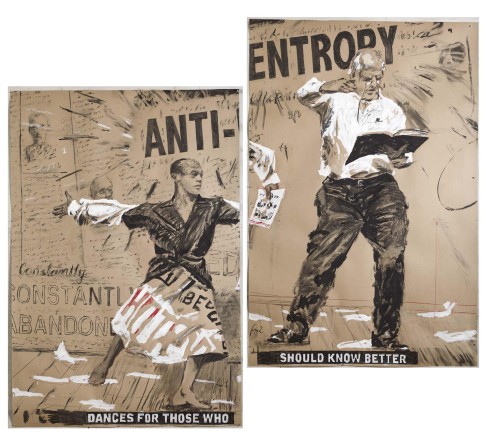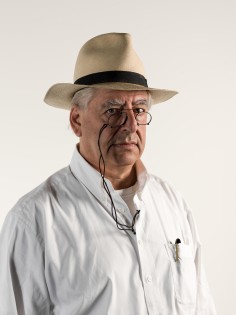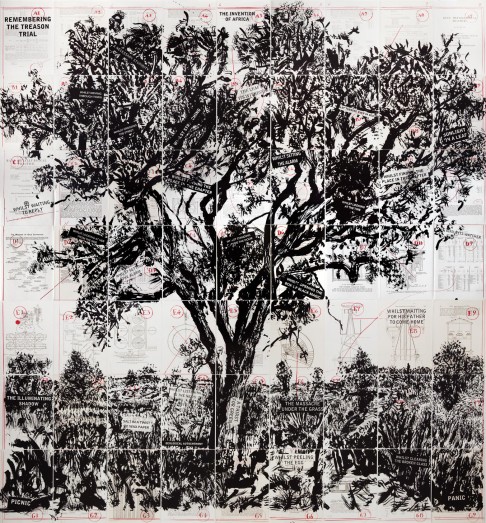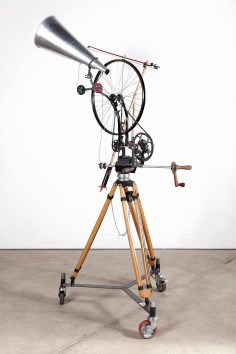
South African artist William Kentridge on his Beijing retrospective
The artist tells Payal Uttam his work has always married the political and the personal
South African artist William Kentridge was six when he stumbled across a box in his father's study in Johannesburg. What he discovered was to have a big impact on his life.
"I was ... expecting it to be a box of chocolates, but inside were photographs of people who had been shot dead," he recalls.
The images were from a police massacre in Sharpeville in 1960. His father was an anti-apartheid lawyer defending the victims' families.
"I was shocked. It was like coming across pornography, both fascinating and impossible to look at," says Kentridge, now 60. "That was a brutal understanding that the world is a dangerous, difficult place."
The incident would remain in his mind, and decades later, gut-wrenching images of corpses like those he saw as a child would resurface in his raw charcoal drawings.
A vast collection of his works is now on show at Beijing's Ullens Centre for Contemporary Art (UCCA). The retrospective features an array of media including artworks in India ink, charcoal, linocut, and silk-screen printing on paper, as well as a number of multichannel video pieces and one large-scale installation in the form of an operatic model complete with mechanical puppet actors.
A draughtsman, filmmaker and sculptor, Kentridge made his mark on the international art scene with his roughly hewn animations that brought his country's horrifying history to life.
Most compelling was his technique of drawing an image with charcoal then erasing it and redrawing it onto the same stained surface. By photographing the stills along the way, he formed a palimpsest of characters in the fraught landscape of South Africa since the late 1980s.

"That was his first real breakthrough," says UCCA director Philip Tinari, "this idea that animation didn't need to be massaged [into something pristine]. It was more interesting that it showed its traces. In society, people often do betray the traces [of the history] that came before."
Not unlike his characters Soho and Felix - whom he resembles - the artist is coloured by his past.
Growing up in a family of lawyers battling injustice inevitably influenced him: "I also wanted to find meaning in the world, but not through the logical processes of legal argument. I took a different approach to similar questions."

After failing to make it as an actor in Paris, Kentridge embarked on a career in art aged 30. Besides drawing, he did projections and directing at a puppet company.
Curators discovered his politically charged figurative sketches and films after the cultural boycott of South Africa had ended. Only in 1997 did he get his first major international exposure at Documenta X.
"They were fascinated by the history and the simplicity of the technique. It was different to other works of contemporary art," says Kentridge. "It was more modest and clearly handmade."
Considering this was the era of conceptual artists such as Jeff Koons, one wonders how he managed to survive. Kentridge grins.
"I have no idea," he says. "There were several group exhibitions where I said: 'I'm happy to be here, but I don't understand the work around me or what I'm doing next to it.'"
Today Kentridge's voice continues to command attention and stands out from those of his peers. Not only is he known for his drawings, installations and films reflecting injustice and oppression, but he has also made a name for himself in opera circles for his innovative productions including Shostakovich's adaptation of Gogol's , and Mozart's .
His current retrospective, titled "Notes Towards a Model Opera", is a sweeping look at his multifaceted career.
Tinari describes the show as being structured not chronologically but rather in ever-widening circles, starting with a nucleus of work that explores Kentridge's immediate surroundings of Johannesburg and moving outwards to universal pieces, including those that critique the Enlightenment and investigate the concept of time.

The exhibition culminates in the artist's broad exploration of China. Along the way, one can find parallels between the failed utopia of apartheid South Africa and the shortcomings of Maoist China.
Last year, Kentridge travelled to Beijing, Shanghai and Nanjing to gather information and inspiration. "It's exciting because you get lots of important international artists who want to do shows in China, but it's very rare that they put in so much effort to engage with the context," says Tinari.
Instead of creating a single coherent piece that addressed his interest in the Cultural Revolution, Kentridge decided to zoom out and create works that tie elements from China's history to incidents in other parts of the world and experiences from his own life.
One feels that we are the goat tethered to the stake, waiting for the tiger (China) to devour us
Among the most vivid images is that of a sparrow, which flaps its wings frantically through the flipping pages of a book in the video work that gives the retrospective its title. This was also screened in Hong Kong in June as part of , a lecture-performance by the artist. The image was inspired by Mao Zedong's irrational campaign to eliminate sparrows in an effort to improve harvests.
"People were told to kill sparrows by banging pots and pans so the birds would never land and die of exhaustion," he says. Yet the death of sparrows brought swarms of locusts.
Explaining its resonance today, he says: "That taught us the danger of assuming the arrogance that one can control the world." Kentridge adds that "the sound echoes across time from China in the 1950s to Taksim Square in Turkey in 2014, when people were getting out their pots and pans to register protest".
More than just a meditation on China, his new works look at the relationship of individual experience to collective history.
It's also about his way of viewing the world: "When you say: 'OK, here's a description of the Cultural Revolution', you are taking it from many different possible frameworks and creating one final version.
"The single story or view is a desperate construction we have to make all the time to make sense of the world … but every reduced picture cuts out so much at the edges."

For Kentridge, exploring these "edges" can reaffirm our humanity. Since his early days when he made smudged drawings emerge from a blemished surface, Kentridge has been suspicious of a clearly defined representation of the world.
"I think there needs to be the mess of thinking, the mess of understanding. [When there's] clarity in political art, it's a simplification of the world and a misrepresentation."
Asked why the Beijing exhibition is significant today, Kentridge launches into larger political questions about China's role in Africa and reveals that the dark underbelly of the show is a story of uncertainty and doubt.
"One feels that we are the goat tethered to the stake, waiting for the tiger [China] to devour us,"he says.
The artist also wonders aloud whether the mainland's increasing power in the continent is a new form of colonialism.
"It starts with China building a lot of infrastructure," he says. "There is a generosity, but you feel at some point the bill is going to be presented. And will the African countries be able to pay? I suspect not."
In many senses, the show's titular video work, which centres on an armed South African dancer Dada Masilo, evokes Kentridge's concerns. As she flutters en pointe carrying a gun through a complex terrain - spanning maps from the Chinese wars of the 1930s to Cultural Revolution posters - one can't help but see her as a paradox, the simultaneous strength and vulnerability of Africa.
While it seems a pessimistic note upon which to end, it's these difficult questions that affirm the power of Kentridge's art.
As he once eloquently declared: "I am interested in a political art, that is to say, an art of ambiguity, contradiction, uncompleted gestures and uncertain endings - an art that keeps optimism in check and nihilism at bay."
Until August 30 at the Ullens Centre for Contemporary Art in Beijing

